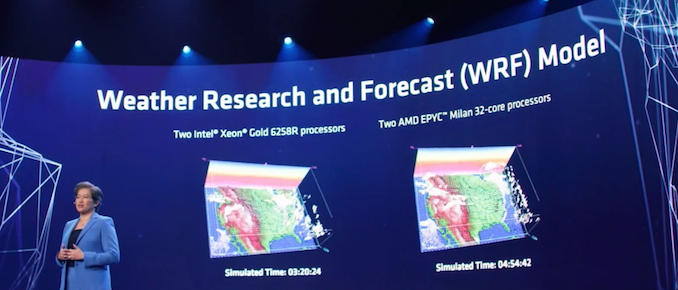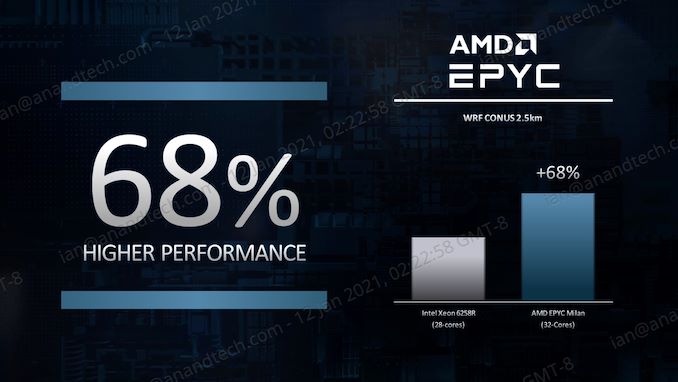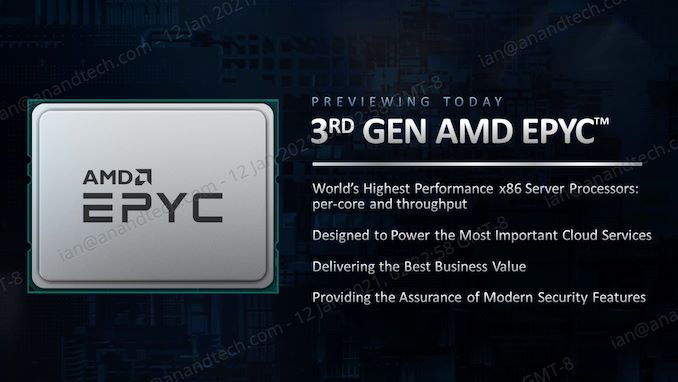AMD Previews 3rd Gen EPYC ‘Milan’ Performance
by Dr. Ian Cutress on January 12, 2021 12:00 PM EST- Posted in
- CPUs
- AMD
- Enterprise
- Trade Shows
- EPYC
- Milan
- CES 2021

Since the announcement of AMD’s Zen 3 core microarchitecture, we’ve been expecting three series of products to be announced: desktop Ryzen, mobile Ryzen, and enterprise EPYC. So far the desktop parts are now launched and at retail (if you can find them), and the mobile Ryzen processors are part of AMD’s CES disclosures this week for retail in February. That only leaves Zen 3-based EPYC, which AMD has decided to preview as part of its CES keynote presentation today.
As far as the design of Zen 3 EPYC ‘Milan’ processors go, we are expecting an almost seemless transition from the previous Zen 2 EPYC ‘Rome’ ecosystem, with pin-compatible processors offering up to 64 cores and with 128 PCIe 4.0 lanes. For performance, if the desktop processors are anything to go by, we should expect to see +19% IPC gains as well. The question remains as to frequencies and efficiency, and when the time comes for AMD to announce the product stack, we will see where the solution lies relative to the competition – should AMD have a significant competitive advantage, no doubt prices will rise in line as well. The previous generation EPYC 7742 had a ‘list price’ of $6950 for comparison.
In today’s keynote presentation, AMD CEO Dr. Lisa Su showcased weather prediction simulation code known as WRF, with two of the new 32-core Milan processors up against Intel’s popular 28-core Xeon Gold 6258R (we’ve reviewed these). The demo showcased simulating a 6 hour weather pattern over the continental US, to which dual socket Milan was 46% faster than Intel. This was computed based on the final frame cut-away from the simulation in the keynote, which showed that where Intel was 56% complete, AMD was 82% complete.

+68% for single socket, +46% for dual socket
AMD’s own metric then showed a +68% difference when comparing a single socket solution. AMD did not provide exact details on the rest of the system used in their testing. It should be clear that because this is a preview, we cannot validate AMD's performance claims.
We are expecting more details about Milan and AMD’s portfolio later this year. Sooner rather than later.



-page-023_carousel_thumb.jpg)
-page-024_carousel_thumb.jpg)









10 Comments
View All Comments
iamgenius - Tuesday, January 12, 2021 - link
Anything about zen 3 threadrippers?ImSpartacus - Friday, January 15, 2021 - link
AMD is probably too supply limited to spare any die for threadripper.Calin - Wednesday, January 13, 2021 - link
"which showed that where Intel was 56% complete, AMD was 82% complete."Why would I choose AMD over Intel when neither can do (finish) the job?
Or AMD, please put do better than that...
boeush - Wednesday, January 13, 2021 - link
Curious. Single-processor advantage is 68%, but dual-processor advantage drops to 43%. Does that mean that AMD's infinity fabric is, relatively speaking, a significant bottleneck as compared to Intel's UPI? (Conversely: how much better would AMD's multiprocessor design scale if they improved their interconnect tech to Intel's level; in other words, how much performance is AMD leaving on the table, so far?)boeush - Wednesday, January 13, 2021 - link
ech; "43%" was supposed to be 46% (it's been a few years since the last time I complained about inability to edit comments on Anandtech; is it too soon to complain again?)scineram - Thursday, January 14, 2021 - link
No.Krysto - Friday, January 15, 2021 - link
I think it has more to do with 2 things:1) Usually multi-core clock speeds are lower than single-core, especially in the data center, because of power limits.
2) The single-core performance increased more than the multi-core performance did because the multi-core one was already highly optimized before, so there wasn't that much room to grow. But the single-core performance had a lot of room to grow with say much bigger cache sizes.
Drkrieger01 - Wednesday, January 27, 2021 - link
Don't forget, with AMD's massive increase in core counts versus Intel, you can go with single socket solutions to get the cores you need instead of having to have extra sockets. While this can bottleneck you with other configurations (less RAM/PCIe), they do have a generous offering when you look at the whole of the product and not one metricsniarn - Thursday, January 14, 2021 - link
I'm excited to see what kind of successor they have for the EPYC 7282. That one currently offers the lowest cost per core.Onlinercasino - Tuesday, April 27, 2021 - link
The best way to know more about the online casinos’ industry is to read professional reviews on Onlinercasino website. Follow one of the best casino blogs and get all updated news.https://onlinercasino.ca/casino-news/